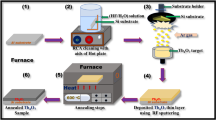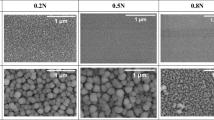Abstract
The thermodynamic approach to determine the phase-chemical composition of thin films formed on the beryllium surface under laser exposure in air and nitrogen gas environments is suggested. Laser marking in a gas environment is used to create contrast patterns on beryllium which is a base material for spherical rotors of the electrostatic gyro. According to thermodynamical calculations of isobaric-isothermal potentials (Gibbs thermodynamic potentials) and kinetic analysis of the chemical reactions, a formation of Be3N2 in nitrogen and BeO in air atmosphere during laser marking of beryllium has the highest probability. As a result, it is possible to control the conductivity of the laser-marked patterns by changing the content and partial pressures of the components of the gas environment. Simulated results agree with the experimental data provided by X-ray diffraction, energy-dispersive X-ray spectroscopy, and scanning probe microscopy (conductivity).
Similar content being viewed by others
References
Kolbasov BN, Khripunov VI, Biryukov AY (2016) On use of beryllium in fusion reactors: resources, impurities and necessity of detritiation after irradiation. Fusion Engineering and Design 109:480–484
Egorov AV, Landau BE, Levin SL, Romanenko SG (2012) Rotor motion in a strapdown electrostatic gyro onboard an orbiting spacecraft. Gyroscopy Navig 3:144–151
Perera LC, Raymond O, Henderson W, Plieger PG (2017) Advances in beryllium coordination chemistry. Coord Chem Rev 352:264–290
Liua P, Zhan Q, Hu W et al (2017) Microstructure evolution of beryllium with argon ion irradiation. Nuclear Materials and Energy 13:99–103
Liu X, Zhang P, He S et al (2018) Effect of beryllium content and heat treatment on microstructure and yield strength in Be/6061Al composites. J Alloys Compd 743:746–755
He S, Ma Y, Ye H et al (2017) Ceramic oxide coating formed on beryllium by micro-arc oxidation. Corros Sci 122:108–117
Luo F, Ong W, Guan Y, Li F et al (2015) Study of micro/nanostructures formed by a nanosecond laser in gaseous environments for stainless steel surface coloring. Appl Surf Sci 328:405–409
Ahmed Obeidi M, McCarthy E, Brabazon D (2018) Laser surface processing with controlled nitrogen-argon concentration levels for regulated surface life time. Opt Lasers Eng 102:154–160
Hu Z, Zhu H, Nie X et al (2018) On the role of atmospheric oxygen into mechanical properties and fracture behavior of selective laser melted AlCu5MnCdVA. Mater Des 150:18–27
Yulmetova OS, Yulmetova RR, Matyzhonok VN (2011) Research on the contrast of laser marks on precise surfaces of metal. Proc. SPIE 7996. https://doi.org/10.1117/12.886252
Yulmetova OS, Tumanova MA (2017) Laser marking of contrast images for optical read-out systems. J Phys Conf Ser 917:052007
Scherbak A, Yulmetova O (2018) Contrast image formation based on thermodynamic approach and surface laser oxidation process for optical read-out systems. Opt Laser Technol 101:242–247
J W Gibbs, H A Bumstead, R G Van Name, W R Longley (1928) The collected works of J Willard Gibbs: In two volumes. Longmans, New York
Tosun I (2012) The thermodynamics of phase and reaction equilibria, 1st edn. Elsevier Science, Oxford
Laidler K (1984) The development of the Arrhenius Equation. J Chem Educ, Onawa
Gulbransen EA, Andrew KF (1950) The kinetics of the reactions of beryllium with oxygen and nitrogen and the effect of oxide and nitride films on its vapor pressure. J Electrochem Soc 11:383–395
Belyaev SN, Scherbak AG (2016) The influence of structural and phase changes of the layer modified by laser treatment on the optical characteristics of raster patterns (in Russian). Voprosi Materialovedeniya 1(85):1–9
Walsh KA (2009) Beryllium chemistry and processing. ASM Int
Floyd DR, Lowe JN (2014) Beryllium science and technology. Springer
Hausner HH (1965) Beryllium: its metallurgy and properties. University of California Press
Funding
This work was financially supported by Government of Russian Federation (Grant 08-08).
Author information
Authors and Affiliations
Corresponding author
Rights and permissions
About this article
Cite this article
Yulmetova, O., Scherbak, A. Composition analysis of thin films formed on beryllium surfaces under pulsed laser action by the method of chemical thermodynamics. Int J Adv Manuf Technol 97, 3231–3236 (2018). https://doi.org/10.1007/s00170-018-2216-2
Received:
Accepted:
Published:
Issue Date:
DOI: https://doi.org/10.1007/s00170-018-2216-2




